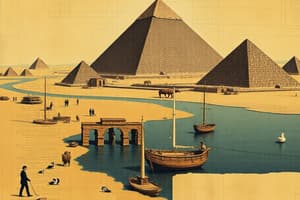Podcast
Questions and Answers
What was the primary role of pharaohs in ancient Egyptian society?
What was the primary role of pharaohs in ancient Egyptian society?
- To oversee agricultural production
- To manage trade routes
- To serve as military leaders
- To act as intermediaries between gods and people (correct)
Which structure is most emblematic of ancient Egyptian architecture?
Which structure is most emblematic of ancient Egyptian architecture?
- The Great Pyramid of Giza (correct)
- The Colosseum
- The Parthenon
- The Hagia Sophia
What was the significance of the Nile River for ancient Egyptians?
What was the significance of the Nile River for ancient Egyptians?
- It was their primary religious site
- It provided a source of gold and precious metals
- It was crucial for agriculture, trade, and transportation (correct)
- It served as a border for their empire
Which dynastic period is known for the construction of many pyramids?
Which dynastic period is known for the construction of many pyramids?
What was the ancient Egyptian writing system primarily used for?
What was the ancient Egyptian writing system primarily used for?
Ancient Egyptians were known for their advances in which fields?
Ancient Egyptians were known for their advances in which fields?
What ultimately led to the decline of ancient Egyptian civilization?
What ultimately led to the decline of ancient Egyptian civilization?
How did ancient Egyptian civilization influence subsequent cultures?
How did ancient Egyptian civilization influence subsequent cultures?
Flashcards are hidden until you start studying
Study Notes
Overview of Egyptian Civilization
- Ancient Egyptian civilization flourished along the Nile River from around 3100 BCE to 30 BCE.
- Known for its rich culture, monumental architecture, and complex society.
Geography
- The Nile River was crucial for agriculture, trade, and transportation.
- Desert on both sides provided natural protection from invasions.
Society and Culture
- Social Structure: Pharaohs (kings) at the top, followed by nobles, priests, soldiers, merchants, farmers, and slaves.
- Religion: Polytheistic, worshipping gods like Ra (sun god), Osiris (afterlife), and Isis (fertility).
- Writing System: Hieroglyphics used for religious texts, monumental inscriptions, and administrative records.
Achievements
- Architecture: Pyramids (e.g., Great Pyramid of Giza), temples, and tombs (e.g., Valley of the Kings).
- Art: Known for sculptures, paintings, and intricate jewelry that depicted gods, pharaohs, and everyday life.
- Mathematics and Medicine: Advances in geometry for construction, knowledge of anatomy for medical practices.
Pharaonic Rule
- Pharaohs considered divine, serving as intermediaries between gods and people.
- Major dynasties: Old Kingdom (pyramids), Middle Kingdom (literature and art), New Kingdom (empire expansion).
Economy
- Based on agriculture, particularly wheat and barley.
- Trade routes extended to neighboring regions for goods like gold, incense, and timber.
Decline
- Gradual decline due to foreign invasions (e.g., Assyrians, Persians, Greeks).
- Final conquest by Rome in 30 BCE, marking the end of ancient Egyptian civilization.
Legacy
- Influenced architecture, art, and culture in subsequent civilizations.
- Continues to be a subject of study and fascination in modern times.
Overview of Egyptian Civilization
- Ancient Egyptian civilization emerged around 3100 BCE and lasted until 30 BCE, primarily along the Nile River.
- Renowned for its cultural richness, monumental architecture, and structured society.
Geography
- The Nile River was vital for sustaining agriculture, facilitating trade, and enabling transportation.
- The surrounding deserts offered natural defenses, protecting against invasions from foreign entities.
Society and Culture
- Social Hierarchy: Comprised of Pharaohs at the apex, followed by nobles, priests, soldiers, merchants, farmers, and slaves.
- Religious Beliefs: Practiced polytheism, worshiping deities such as Ra (god of the sun), Osiris (god of the afterlife), and Isis (goddess of fertility).
- Writing System: Utilized hieroglyphics for religious literature, monumental inscriptions, and administrative documentation.
Achievements
- Architectural Marvels: Included the construction of the pyramids (e.g., Great Pyramid of Giza), alongside grand temples and burial sites like the Valley of the Kings.
- Artistry: Celebrated for its sculptures, frescoes, and ornate jewelry reflecting deities, pharaohs, and daily life scenarios.
- Scientific Advancements: Progressed in geometry for architectural purposes and developed anatomical knowledge for medical treatments.
Pharaonic Rule
- Pharaohs were deemed divine figures, acting as conduits between the deities and the populace.
- Significant dynasties included the Old Kingdom (focused on pyramid construction), Middle Kingdom (noted for literary and artistic achievements), and New Kingdom (characterized by territorial expansion).
Economy
- Primarily agricultural, centered around the cultivation of wheat and barley.
- Established trade routes that extended to neighboring areas for acquiring commodities like gold, incense, and timber.
Decline
- Experienced a gradual decline initiated by foreign invasions, notably from the Assyrians, Persians, and Greeks.
- The conquest by Rome in 30 BCE marked the definitive end of ancient Egyptian civilization.
Legacy
- Egyptian civilization has left an enduring impact on architecture, art, and cultural practices observed in later societies.
- Remains a fascinating topic for scholarly exploration and public interest in contemporary times.
Studying That Suits You
Use AI to generate personalized quizzes and flashcards to suit your learning preferences.




